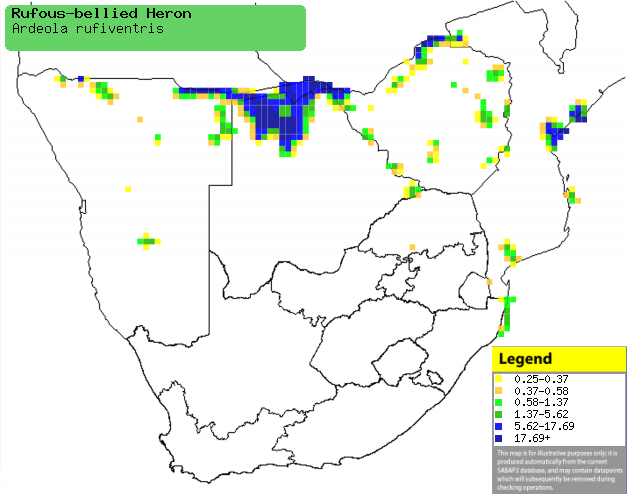|
Ardeola rufiventris
(Rufous-bellied heron)
[= Butorides rufiventris]
Rooipensreier [Afrikaans]; Hakaruu (generic term for
short-necked herons and bitterns) [Kwangali]; Roodbuikreiger [Dutch];
Crabier à ventre roux [French]; Rotbauchreiher [German];
Garça-de-barriga-vermelha [Portuguese]
Life
> Eukaryotes >
Opisthokonta
> Metazoa (animals) >
Bilateria >
Deuterostomia > Chordata >
Craniata > Vertebrata (vertebrates) > Gnathostomata (jawed
vertebrates) > Teleostomi (teleost fish) > Osteichthyes (bony fish) > Class:
Sarcopterygii (lobe-finned
fish) > Stegocephalia (terrestrial
vertebrates) > Tetrapoda
(four-legged vertebrates) > Reptiliomorpha > Amniota >
Reptilia (reptiles) >
Romeriida > Diapsida > Archosauromorpha > Archosauria >
Dinosauria
(dinosaurs) > Saurischia > Theropoda (bipedal predatory dinosaurs) >
Coelurosauria > Maniraptora > Aves
(birds) > Order: Ciconiiformes
> Family: Ardeidae
Distribution and habitat
Occurs from southern DRC through Uganda, Tanzania, Zambia,
Angola and Malawi to South Africa. In southern Africa, it is generally uncommon in patches
of Zimbabwe, central and southern Mozambique, eastern South Africa and central
Namibia, while more abundant in northern Botswana and the Caprivi Strip
(Namibia). It generally prefers flooded grassland and the shore of permanent
water bodies (fringed by reedbeds).
|
 |
|
Distribution of Rufous-bellied heron in southern
Africa, based on statistical smoothing of the records from first SA Bird
Atlas Project (©
Animal Demography unit, University of
Cape Town; smoothing by Birgit Erni and Francesca Little). Colours range
from dark blue (most common) through to yellow (least common). |
Predators and parasites
- Predators
- of chicks
- of eggs and chicks
Movements and migrations
Resident and sedentary on the Okavango Delta,
while it is thought to be a breeding migrant to Zimbabwe in mid to
late summer. It also breeds on the Nyl River flood plain, Limpopo Province in the
period from December-May.
Food
It mainly eats fish, amphibians, insects and worms, doing
most of its foraging by standing still or slowly moving through shallow water,
stabbing any prey that comes too close.
Breeding
- Monogamous, solitary or colonial nester, sometimes breeding in groups of
2-4 pairs.
- The nest is a shallow platform of reeds and twigs, lined with grass or
flowers. It is typically placed in a well-foliaged tree or bush, or
alternatively in a Phragmites reedbed.
- Egg-laying season is nearly year-round.
- It lays 1-4 eggs, which are incubated by both sexes for roughly 21 days.
- The chicks are able to fly at about 24 days old, and can fly strongly
about week later.
Threats
Not threatened.
References
-
Hockey PAR, Dean WRJ and Ryan PG 2005. Roberts
- Birds of southern Africa, VIIth ed. The Trustees of the John Voelcker
Bird Book Fund, Cape Town.
|
